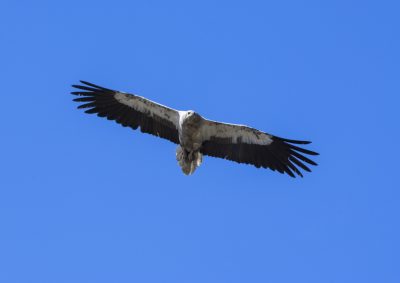Egyptian Vulture success in Puglia
If you are lucky enough to have done any birding in Spain, you are likely to have come across large flocks of Griffon vultures soaring overhead. Amongst these huge vultures, one or two smaller birds may often be noted; mainly white, with black flight feathers and yellow face; Egyptian vultures. Smaller is certainly a relative term here; the Egyptian vulture has a similar wingspan to the Osprey. Most European birds winter in sub-Saharan Africa, migrating as single birds or in small parties. Spanish birds sensibly cross via Gibraltar; Italian birds are thought to island-hop on a Sicily to Tunisia route to avoid a long sea crossing.

Egyptian Vulture
Spain has, by far, the largest European population of Egyptian vultures, at somewhere over a thousand breeding pairs. In Italy, however, there is a rather bleak tale of a small population in gradual decline. Between the beginning of the 1970s and the early 1990s the breeding population in the Italian peninsula declined from 29 to 9 breeding pairs. A 2001 study attributed 71% of breeding failures in Italy to human activities and direct persecution. The Egyptian vulture has disappeared from most historic breeding sites (typically steep cliffs and crags) in central southern Italy. Today the population is estimated as 6-8 breeding pairs; it stands on the brink of extinction as an Italian breeding species.
The same 2001 study showed that nesting cliff occupation rate, percentage of breeding attempts that fledged at least one chick and mean number of fledged young were negatively correlated with distance to an artificial feeding site. The National Action Plan for the Egyptian vulture identified feeding stations as a key action to boost breeding success. This measure had already been successfully used for the small population in the South of France. Sites were identified in Puglia (the ‘heel’ of Italy) and the neighbouring province of Basilicata, where two breeding pairs were active but food was scarce.
Use of feeding stations is just one element of an ambitious EU-LIFE funded project to check the decline of this impressive species in Italy and the Canary Islands. The scope of this project is an article in itself, but elements include the monitoring of nesting sites, the management of feeding points, the development of activities against the illegal use of poison and the release of captive-bred birds. Both in Italy and in the Canary Islands, extensive modifications will be carried out on power lines, so that vultures on migration can rest safely on poles and pylons.
What of LIPU-UK? In early 2018, your charity was asked to provide short-term financial support for Egyptian Vulture feeding stations in Puglia and Basilicata, near the Gravina di Laterza LIPU reserve. The EU-LIFE project had been delayed and interim funding was urgently required. Given the status of the Egyptian vulture in Italy, the Trustees agreed that temporary support from LIPU-UK was essential. Eur 2,500 was approved and transferred outside of the normal annual funding cycle. As a result, LIPU was able to activate a feeding station in time for the 2018 breeding season. The station was constantly supplied with meat courtesy of LIPU-UK during the breeding season.

The action was aimed at providing supplementary feeding to one pair situated in Parco della Murgia Materana and potentially a second breeding pair located in the surroundings (Parco Nazionale dell’Appennino Lucano). Other species such as the Red kite and the Black kite were also expected to benefit from the feeding stations.
It is satisfying to report that the feeding station was used by the two breeding pairs. Furthermore, both the pairs managed to raise two chicks. Usually, one of the chicks does not reach maturity, but in this case the four chicks were observed until they abandoned the feeding site. We can therefore state that we increased the probability of surviving until maturity for these chicks, but we cannot prove that they survived until starting migration. Considering that the species is in immediate risk of local extinction we hope you will agree that the investment was well worth it.
Matt Hines, LIPU-UK Trustee


